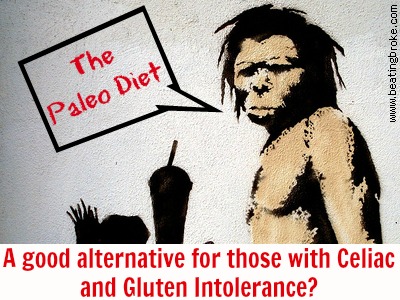I’m a carb and sugar lover, and I’m guessing I’m not alone among Americans. Pizza, bread sticks, pasta, bread. . . we are a nation that loves carbs. For many of us, though, digesting carbs is a challenge. Dr. Joseph Murray of the Mayo Clinic analyzed blood samples from the 1950s to those now and “confirms estimates that about 1 percent of U.S. adults have [Celiac] today, making it four times more common now than it was 50 years ago” (CBSNews.com). Nearly that same amount has Celiac disease but have not yet been diagnosed
Even if you don’t have Celiac, you may have trouble with carbs. I’m intolerant to gluten, wheat and many other grains. When I eat them, I feel like I can’t breathe and get dizzy. Thanks to my many intolerances, I turned to the Paleo Diet.
What Is the Paleo Diet?
 The Paleo Diet is based on the idea that you’re health will be optimal if you eat like our Paleolithic ancestors did. That means eating grass fed meat, fish, fruits, vegetables, eggs and nuts.
The Paleo Diet is based on the idea that you’re health will be optimal if you eat like our Paleolithic ancestors did. That means eating grass fed meat, fish, fruits, vegetables, eggs and nuts.
What’s off limits? Grains, rice, sugar, beans, processed foods, dairy, and certain types of oil. If you’re like most Americans, the off limit items probably make up a large portion of your diet, so if you’re thinking of moving to a Paleo diet, I recommend transitioning slowly. Maybe first give up sugar, then dairy, then grains, etc. Give yourself at least a month to transition off each so you don’t feel deprived giving everything up at once.
Why Grass Fed Meat?
Traditional meat on the market today comes from animals that are fed a diet heavy on corn and are fattened up on feed lots. Their diet causes them to produce less omega-3. When we consume the meat, we develop high levels of omega-6, which is bad for the human body and can cause inflammation.
Cows and lambs especially that are fed an entirely grass fed diet are rich in omega-3, which is good for your body. According to a 2011 study in the British Journal of Nutrition, “Eating moderate amounts of grass-fed meat for only 4 weeks will give you healthier levels of essential fats. The British research showed that healthy volunteers who ate grass-fed meat increased their blood levels of omega-3 fatty acids and decreased their level of pro-inflammatory omega-6 fatty acids. These changes are linked with a lower risk of a host of disorders, including cancer, cardiovascular disease, depression, and inflammatory disease” (Eat Wild).
If you’re going to be eating a large quantity of meat on the Paleo diet, you want it to be the best meat available.
Other Health Benefits of the Paleo Diet
You may have seen the project where a photographer captured what families around the world consume in a week. What is most startling is how much processed foods and how few fruits and vegetables Americans eat.
If you follow the Paleo diet, yes, you’re eating a diet heavy in meat (but if it’s grass-fed, it’s healthier meat), BUT you’re also eating a diet rich in fruits and vegetables. Before I began the Paleo diet, I’m ashamed to admit that I only ate 2 to 3 fruits and vegetables a day. Now I easily get 7 to 10 servings of fresh fruit and vegetables a day.
What Comes Next
Sure, maybe now you’re convinced that there are benefits to following the Paleo diet, especially if you have a gluten or even dairy intolerance. However, I’m guessing you’re probably ready to argue that the Paleo diet is too expensive to follow. While it IS more expensive than a traditional American diet, there are ways to cut corners and make the Paleo diet more affordable, which I’ll explain in my next post.
Have you tried the Paleo diet? What are your thoughts?
Original Image Credit: Banksy’s Caveman by Lord Jim, on Flickr
Melissa is a writer and virtual assistant. She earned her Master’s from Southern Illinois University, and her Bachelor’s in English from the University of Michigan. When she’s not working, you can find her homeschooling her kids, reading a good book, or cooking. She resides in New York, where she loves the natural beauty of the area.


